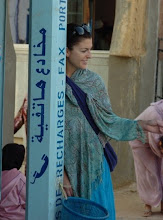Volubilis
After staying in Meknes for the day, we headed out to the ancient city of Volubilis. Volubilis is an interesting paradox because it is built in Roman style, so the Moroccans don’t identify it as Moroccan, however historians know that Volubilis was built by Moroccans, and that it was only influenced by Roman architecture. This is true about some other aspects about Moroccan culture; there are some aspects of Moroccan culture that Moroccans don’t appreciate because they don’t feel like it is theirs. However, as is the case with Volubilis, there are blatant inconsistencies in the Roman-style architecture that indicate that Romans did not, in fact, build the city. In looking just at the columns that were left standing in the city, there is a juxtaposition of Roman, Corinthian, and something Moroccan about the designs. It was interesting to me that the guide at the archaeological site confirmed this Moroccan ideology- that Volubilis it is not Moroccan, that it is Roman, because nothing else in Morocco is like it. I think that it is a shame that Moroccans don’t identify with this interesting aspect of their history.

Morocco is a cultural crossroads, and has been for thousands of years. It serves as the passageway from Africa to Europe and from Atlantic to Mediterranean Sea. As such the exchange of cultures, ideas and technology have been going on ever since the Roman age of exploration. Morocco today is characterized by this richness of cultural diversity. This is especially evident in the population that lives here. After a short visit to Morocco, it quickly becomes evident that there are no people that are distinctly “Moroccan.” You cannot look at someone and say that they are of Moroccan descent. There are Berbers, Arabs, Europeans, and Sub-Saharan Africans. Even the royal family is characterized by this ethnic diversity. A long, long time ago, when the slave trade was prevalent in Morocco, women from Mali, seen as the most beautiful in Africa were brought to live in the Sultan’s palace. Many sultans in Moroccan history were born to a beautiful slave woman from Mali, while their fathers were of Arab-Berber descent.
The identity crisis that Volubilis represents has made it difficult to understand the culture and where it comes from. But, regardless of where it comes from, one thing is certain and that is the fact that it is immensely beautiful.
The ruins stand on top of a grassy plateau above fields of green olive groves and yellow grass fields. It was really beautiful the day of our visit, the sky was blue and there was a nice breeze. When it got too hot, we just rested in the shadows of the arches and columns. Although the architecture was really beautiful, the art was truly a sight to behold. Still largely intact are floor mosaics of the Roman gods and goddesses. Some have images of animals and people also, and all of them are truly amazing, considering their age is thousands of years old. I could write more about it, but photos do it more justice…








No comments:
Post a Comment